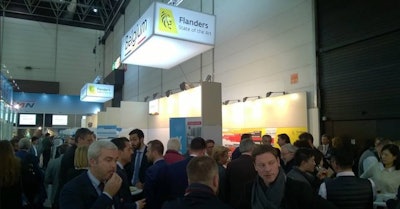
Can you pinpoint what American businesses such as Mohawk, Pfizer and Velcro have in common in terms of production? You likely wouldn’t have guessed they all chose Flanders — Belgium’s northern region with Brussels as it capital — as the location for a recent investment project. And, they’re not alone. Last year, US-based companies funneled no less than $320 million into setting up or expanding their manufacturing operations in Flanders, securing first place in the list of most important foreign investors in the region.
Here are 5 reasons why high-tech American companies are looking across the pond to enhance their manufacturing footprint.
No. 1 — A central and intermodal location
Getting components and raw materials at the right time is crucial to making and distributing products with maximum efficiency. In this regard, Flanders’ logistics strengths contribute heavily to its popularity among American manufacturers.
The region is situated in the heart of the EU and among Europe’s biggest economies: Germany, the UK and France. Despite being only 5,200 square miles in size, it contains 800+ European distribution centers, 4 seaports and 3 international airports. Its railroad and road networks are #1 worldwide when it comes to density per square mile, and its inland waterways are highly interconnected and among the densest in the world as well. With all of this packed in a relatively small area, manufacturing companies can take advantage of both a central location and the potential to organize multi- and even intermodal transport to and from their sites.
No. 2 — An R&D-friendly climate
As Industry 4.0 is shaping the future of advanced manufacturing, numerous industry players look for know-how outside their company walls to support their R&D efforts. In Flanders, these businesses gain access to a knowledge ecosystem that unites the private, the public and the academic realms.
One telling example are the region’s 4 strategic research centers. Supported by the government and working closely with local universities, they cover R&D in nano- and digital tech (imec), mechatronics and process engineering (Flanders Make), biotech (VIB) and multidisciplinary innovation (VITO). Flanders Make, in particular, helps the manufacturing industry develop smart machines, vehicles and factories, and collaborates with sector-dedicated competence centers — such as Sirris and the Open Manufacturing Campus (OMC).
No. 3 — A network of technology suppliers
The days of production plants operating as standalone entities are long gone. To excel in manufacturing, you need a diverse network of suppliers to partner with for research, design, production, testing, and certification purposes.
Active in fields such as mechatronics, automatization, product design, robotics and 3D-printing, these suppliers are often SMEs in Flanders — driving them to work closely together for greater efficiency and enabling them to play in the big league. Despite its small size, Flanders accounts for 8% of the global turnover in additive manufacturing, for instance.
No. 4 — Productivity
In modern manufacturing, skilled and savvy people are critical to driving production processes to their full potential. With around 16% of its active population employed in the manufacturing industry, Flanders has a broad pool of talent in production. Fostering this talent, the region’s education system — which ranks 4th in the WEF’s Global Competitiveness Report 2016-17 — endows people with the skills to handle or develop innovative production methods, infrastructure, processes, etc.
Furthermore, Flanders’ workforce claims 4th place worldwide for productivity, reaching an output of $69 per hour worked according to the 2016 Conference Board ranking. As such, it helps level out employment costs — something that’s particularly relevant for labor-intensive industries like manufacturing — and harness competitiveness.
No. 5 — Cost-effectiveness
It’s no secret that operating in a cost-effective way is pivotal for successful manufacturing. Along with productive workforce and optimal production processes and technologies, access to tax benefits and cash grants is another important way of achieving just that.
Ranging from support for strategic transformation projects to temporary economic unemployment and fiscal advantages for night and shift work, Flanders’ incentives in this respect are surely one of the reasons why over 5,700 high-tech companies have established their manufacturing activities in the region.
More info on setting up manufacturing activities in Flanders is available on the website of investment and promotion agency Flanders Investment & Trade.
Flanders Investment & Trade is a government agency supporting foreign companies looking to invest in Flanders, northern region of Belgium and gateway to Europe.






















